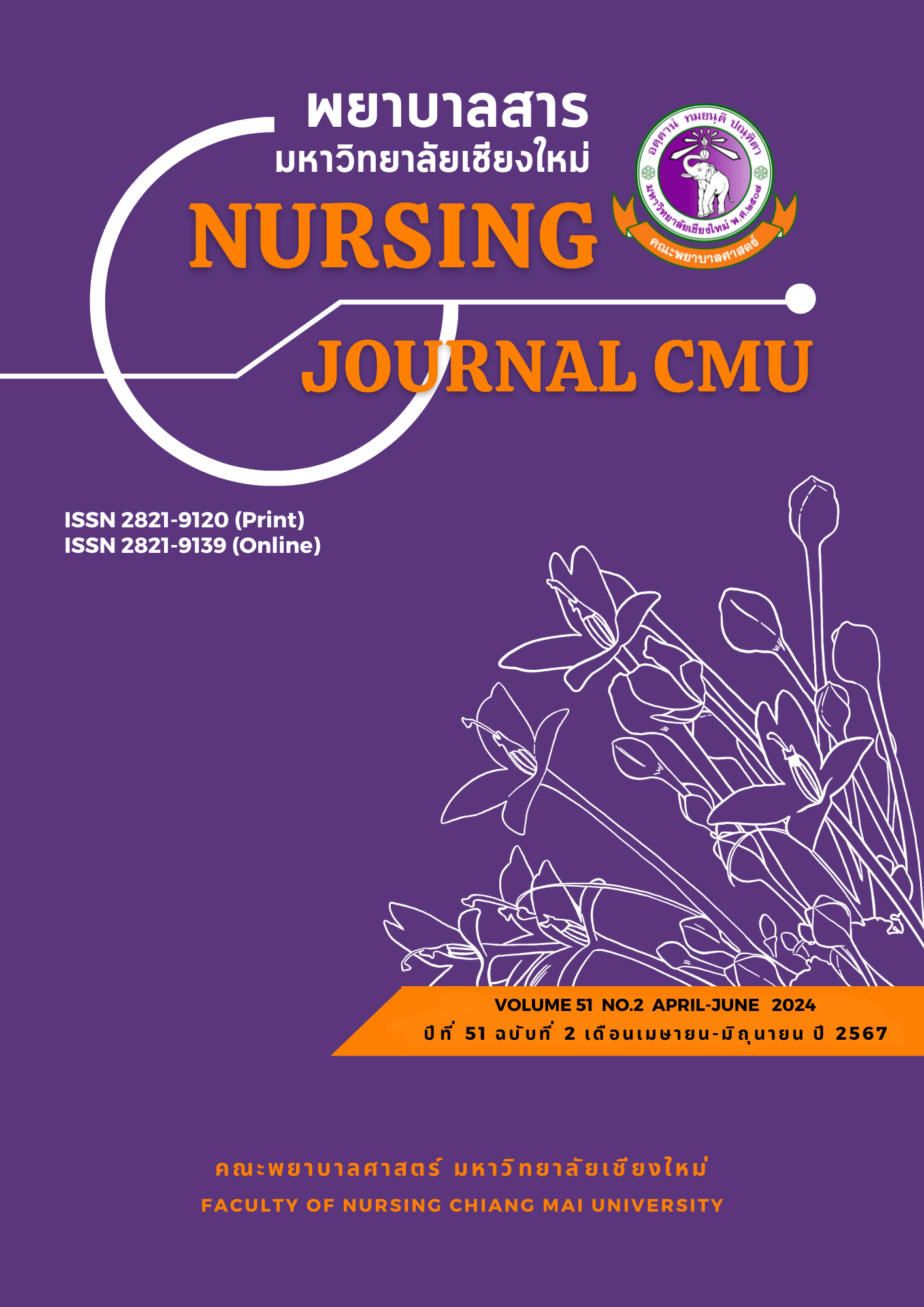Nursing Care for Newborn Infants with Critical Congenital Heart Disease undergoing Therapeutic Cardiac Catheterization: A Case Study
Keywords:
Nursing care, Newborn infants, Critical congenital heart disease, Cardiac catheterizationAbstract
Critical congenital heart disease is an abnormality of the cardiac structures which poses a high risk of blood circulatory crisis from birth. Urgent cardiac catheterization and/or cardiac surgery are necessary within the first few months of life to improve survival rates while waiting for further surgical correction. However, neonatal cardiac catheterization carries a higher risk of complications and death than for other age groups of children. Pediatric nurses require specific knowledge, skills, and good attention in preparing newborn infants before and after cardiac catheterization. During post-cardiac catheterization, newborn infants need close surveillance and evaluation. Implementing the nursing care mentioned above will result in increased efficiency and quality of care for newborns undergoing therapeutic cardiac catheterization.
This article aims to provide knowledge on critical congenital heart disease in newborn infants, therapy and indications for cardiac catheterization, complications that may occur during and after the invasive procedure, and proper nursing care before and after for newborn infants who undergo therapeutic cardiac catheterization, in addition to a case study.
References
Alakhfash, A. A., Jelly, A., Almesned, A., Alqwaiee, A., Almutairi, M., Salah, S., Hasan, M., Almuhaya, M., Alnajjar, A., Mofeed, M., & Nasser, B. (2020). Cardiac catheterization interventions in neonates and infants less than three months. Journal of the Saudi Heart Association, 32(2), 149-156. https://doi.org/10.37616/2212-5043.1051
Aguiar, B. F., Rinaldi, E. C. A., Cintho, L. M. M., da SilvaMartins, C. L., & Zimmerman, M. H. (2016). Importance of nursing care in cardiac catheterization. Cienc Cuid Saude, 15(3), 460-465. https://periodicos.uem.br/ojs/index.php/CiencCuidSaude/article/view/24894/18382
Bansal, N., Misra, A., Forbes, T. J., & Kobayashi, D. (2021). Femoral artery thrombosis after pediatric cardiac catheterization. Pediatric Cardiology, 42(4), 753-761. https://doi.org/10.1007/s00246-020-02537-2
Barry, O. M., Bouhout, I., Turner, M. E., Petit, C. J., & Kalfa, D. M. (2022). Transcatheter cardiac interventions in the newborn: JACC focus seminar. Journal of the American College of Cardiology, 79(22), 2270-2283. https://doi.org/10.1016/j.jacc.2022.03.374
Brooks, T. (2018). Guidelines for anticoagulation in paediatric cardiac patients. https://www.leedsformulary.nhs.uk/docs/PaedCAnticoagulationGuidelines.pdf
Centers for Disease Control and Prevention. (2022). Care and treatment for congenital heart defects. https://www.heart.org/en/health-topics/congenital-heart-defects/care-and-treatment-for-congenital-heart-defects
Chankhao, C. (2019). Neonatal Nursing (2nd ed.). Chulalongkorn University Printing House. (in Thai)
Chiu, T. M., & Chu, S. Y. (2022). Hypersensitivity reactions to iodinated contrast media. Biomedicines, 10(5), 1036. https://doi.org/10.3390/biomedicines10051036
Critchfield, D., Fleming, G. A., Hill, K. D., & Chamberlain, R. (2023). Routine ultrasound after cardiac catheterization in infants can optimize identification and management of vascular thrombosis. Journal of the American College of Cardiology, 81(Suppl. 8), 1602. https://doi.org/10.1016/S0735-1097(23)02046-6
Hill, K. D., Roark, J., & Fleming, G. A. (2019). Cardiac catheterization laboratory. In R. M. Ungerleider, J. N. Meliones, K. Nelson McMillan, D. S. Cooper, & J. P. Jacobs (Eds.), Critical Heart Disease in Infants and Children (3rd ed., pp. 465-479). Elsevier.
Jirapaet, K., & Jirapaet, V. (2022). Newborn health assessment (4th ed.). OS Printing House. (in Thai)
Kumar, P., Joshi, V. S., & Madhu, P. V. (2014). Diagnostic pediatric cardiac catheterization: Experience of a tertiary care pediatric cardiac centre. Medical Journal Armed Forces India, 70(1), 10-16. https://doi.org/10.1016/j.mjafi.2013.01.002
Klompas, M., Branson, R., Cawcutt, K., Crist, M., Eichenwald, E. C., Greene, L. R., Lee, G., Maragakis, L. L., Powell, K., Priebe, G. P., Speck, K., Yokoe, D. S., & Berenholtz, S. M. (2022). Strategies to prevent ventilator-associated pneumonia, ventilator-associated events, and nonventilator hospital-acquired pneumonia in acute-care hospitals: 2022 update. Infection Control & Hospital Epidemiology, 43(6), 687–713. https://doi.org/10.1017/ice.2022.88
Lahiri, S., Qureshi, A. M., Justino, H., & Mossad, E. B. (2022). Percutaneous common carotid artery access for cardiac interventions in infants does not acutely change cerebral perfusion. Pediatric Cardiology, 43, 104-109. https://doi.org/10.1007/s00246-021-02697-9
Lertsapcharoen, P. (2013). Cardiac catheterization. In P. Lertsapcharoen & V. Benjacholamas (Eds.), Congenital heart diseases (pp. 89-103). Sukhumvit printing. (in Thai)
Lince-Varela, R., Restrepo, D., Lince, M., Munoz, D., Vasquez, F., Quijano, J. M., Hincapie, L., Hinestroza, J. F., Velasquez, M., & Bedoya, J. (2021). Complications associated to pediatric cardiac and catheterization congenital heart diseases. Archivos de Cardiología de México, 91(4), 422-430. https://doi.org/10.24875/acm.200003191
Meliota, G., & Vairo, U. (2023). Transcatheter interventions for neonates with congenital heart disease: A review. Diagnostics, 13(16), 2673. https://doi.org/10.3390/diagnostic13162673
Panturut, P. (2014). Nursing care for children of undergoing cardiac catheterization. In T. Layanggool (Ed.), Nursing management for pediatric heart diseases (pp.147-156). Queen Sirikit National Institute of Child Health. (in Thai)
Siriraj Piyamaharajkarun Hospital. (2020). Treatment of congenital heart disease by cardiac catheterization. https://www.siphhospital.com/th/news/article/share/congenital-heart-disease (in Thai)
Suwanbundit, A. (2022). Contrast selection in order to prevent the contrast induced nephropathy. Journal of Siriraj Radiology, 8(2), 53-58 https://sirirajradiology.com/wp-content/uploads/2023/06/05-contrast-in-sig-1.pdf (in Thai)
Tadphale, S., Yohannan, T., Kauffmann, T., Maller, V., Agrawal, V., Lloyd, H., Waller, B. R., & Sathanandam, S. (2020). Accessing femoral arteries less than 3 mm in diameter is associated with increased incidence of loss of pulse following cardiac catheterization in infant. Pediatric Cardiology, 41(5), 1058-1066. https://doi.org/10.1007/s00246-020-02357-4
Thai Association for the Study of Pain. (2018). Clinical guidance for pediatric acute pain management. Noppachai printing. (in Thai)
The Royal Children's Hospital Melbourne. (2020). Nursing guidelines: Care of the patient post cardiac catheterisation. https://www.rch.org.au/rchcpg/hospital_clinical_guideline_index/Care_of_the_patient_post_cardiac_catheterisation/
Wongchan, W. (2023). Nursing care for children of undergoing cardiac catheterization: A case study. Nursing Journal CMU, 50(3), 255-268. (in Thai)
Yangthara, B., & Kitsommart, R. (2022). Role of neonatologist in critical congenital heart disease. In C. Vijarnsorn (Ed.), Critical congenital heart disease in newborn and child (pp. 107-134). Siriraj Books. (in Thai)
Downloads
Published
How to Cite
Issue
Section
License
Copyright (c) 2024 Nursing Journal CMU

This work is licensed under a Creative Commons Attribution-NonCommercial-NoDerivatives 4.0 International License.
บทความที่ได้รับการตีพิมพ์เป็นลิขสิทธิ์ของวารสารพยาบาลสาร
ข้อความที่ปรากฏในบทความแต่ละเรื่องในวารสารวิชาการเล่มนี้เป็นความคิดเห็นส่วนตัวของผู้เขียนแต่ละท่านไม่เกี่ยวข้องกับมหาวิทยาลัยเชียงใหม่ และคณาจารย์ท่านอื่นๆในมหาวิทยาลัยฯ แต่อย่างใด ความรับผิดชอบองค์ประกอบทั้งหมดของบทความแต่ละเรื่องเป็นของผู้เขียนแต่ละท่าน หากมีความผิดพลาดใด ๆ ผู้เขียนแต่ละท่านจะรับผิดชอบบทความของตนเองแต่ผู้เดียว






